Nitrogen levels in Irish rivers reduced overall last year compared to 2023, according to the Environmental Protection Agency (EPA).
It comes as the agency published its annual full monitoring network results of the levels of nitrogen and phosphorus for 2024 which used data from over 1500 national monitoring stations.
The report found that there has been a 10% reduction in river nitrate concentrations in most regions, however, nitrate concentrations in rivers remain too high in the southeastern half of the country.
The EPA said that while the recent improvement in nitrogen concentrations in rivers is very welcome, overall, to deliver improvements in ecological status and to achieve the Water Framework Directive objectives, nutrient losses to water need to be further reduced.
“Nutrient pollution from agriculture is a key issue impacting water quality. Significant actions are underway by the sector to reduce nutrient losses.
“Ongoing and sustained actions will be needed to reduce nutrients to satisfactory levels before the ecological health of our waters will improve.”

Mean nitrate concentrations in groundwater during 2024. / EPA
Nitrogen
There has been an 8% reduction in nitrate concentration in groundwater in the south east region, although groundwater nitrate concentrations have not reduced in other regions.
Last year, 5% of groundwater monitoring sites exceeded the regulatory groundwater threshold value of 37.5mg/l NO3 and 21% of groundwater monitoring sites have mean nitrate concentrations greater than 25mg/l NO3.
There has been a 2% increase in the number of estuaries and coastal waters exceeded the median winder nitrogen threshold, however, the EPA said these water bodies “can take longer to respond to changes in land use practices than rivers”.
The report said: “As groundwater contributes to surface water flow across the catchment, elevated nutrient concentrations may be contributing to an increase in the growth of algae and aquatic plants in rivers and the downstream marine waters.”
Phosphorous levels
Overall, phosphorus concentrations remain stable but have not changed significantly in 2024.
In total, 21% of river monitoring stations have phosphorus concentrations which are greater than the good status environmental quality standard of 0.035mg/l P. The highest river phosphorus concentrations are in areas with poorly draining soils.
“The elevated phosphorus concentrations are impacting the ecological health of these rivers and are contributing to nutrient enrichment in the downstream marine waters,” the report said.
Read more
Wexford IFA launches pilot guide to improving water quality
Over 99% of drinking water of good standard - EPA
Nitrogen levels in Irish rivers reduced overall last year compared to 2023, according to the Environmental Protection Agency (EPA).
It comes as the agency published its annual full monitoring network results of the levels of nitrogen and phosphorus for 2024 which used data from over 1500 national monitoring stations.
The report found that there has been a 10% reduction in river nitrate concentrations in most regions, however, nitrate concentrations in rivers remain too high in the southeastern half of the country.
The EPA said that while the recent improvement in nitrogen concentrations in rivers is very welcome, overall, to deliver improvements in ecological status and to achieve the Water Framework Directive objectives, nutrient losses to water need to be further reduced.
“Nutrient pollution from agriculture is a key issue impacting water quality. Significant actions are underway by the sector to reduce nutrient losses.
“Ongoing and sustained actions will be needed to reduce nutrients to satisfactory levels before the ecological health of our waters will improve.”

Mean nitrate concentrations in groundwater during 2024. / EPA
Nitrogen
There has been an 8% reduction in nitrate concentration in groundwater in the south east region, although groundwater nitrate concentrations have not reduced in other regions.
Last year, 5% of groundwater monitoring sites exceeded the regulatory groundwater threshold value of 37.5mg/l NO3 and 21% of groundwater monitoring sites have mean nitrate concentrations greater than 25mg/l NO3.
There has been a 2% increase in the number of estuaries and coastal waters exceeded the median winder nitrogen threshold, however, the EPA said these water bodies “can take longer to respond to changes in land use practices than rivers”.
The report said: “As groundwater contributes to surface water flow across the catchment, elevated nutrient concentrations may be contributing to an increase in the growth of algae and aquatic plants in rivers and the downstream marine waters.”
Phosphorous levels
Overall, phosphorus concentrations remain stable but have not changed significantly in 2024.
In total, 21% of river monitoring stations have phosphorus concentrations which are greater than the good status environmental quality standard of 0.035mg/l P. The highest river phosphorus concentrations are in areas with poorly draining soils.
“The elevated phosphorus concentrations are impacting the ecological health of these rivers and are contributing to nutrient enrichment in the downstream marine waters,” the report said.
Read more
Wexford IFA launches pilot guide to improving water quality
Over 99% of drinking water of good standard - EPA







 This is a subscriber-only article
This is a subscriber-only article










SHARING OPTIONS: